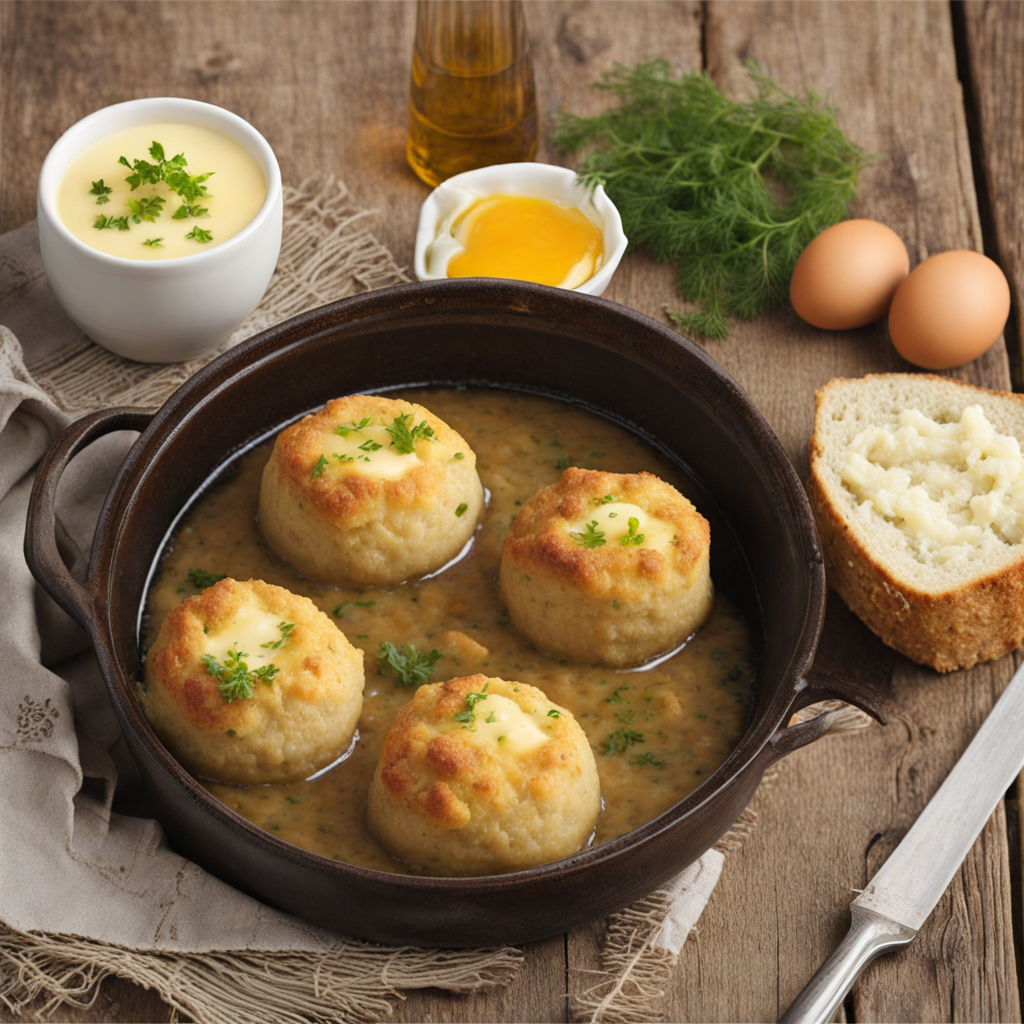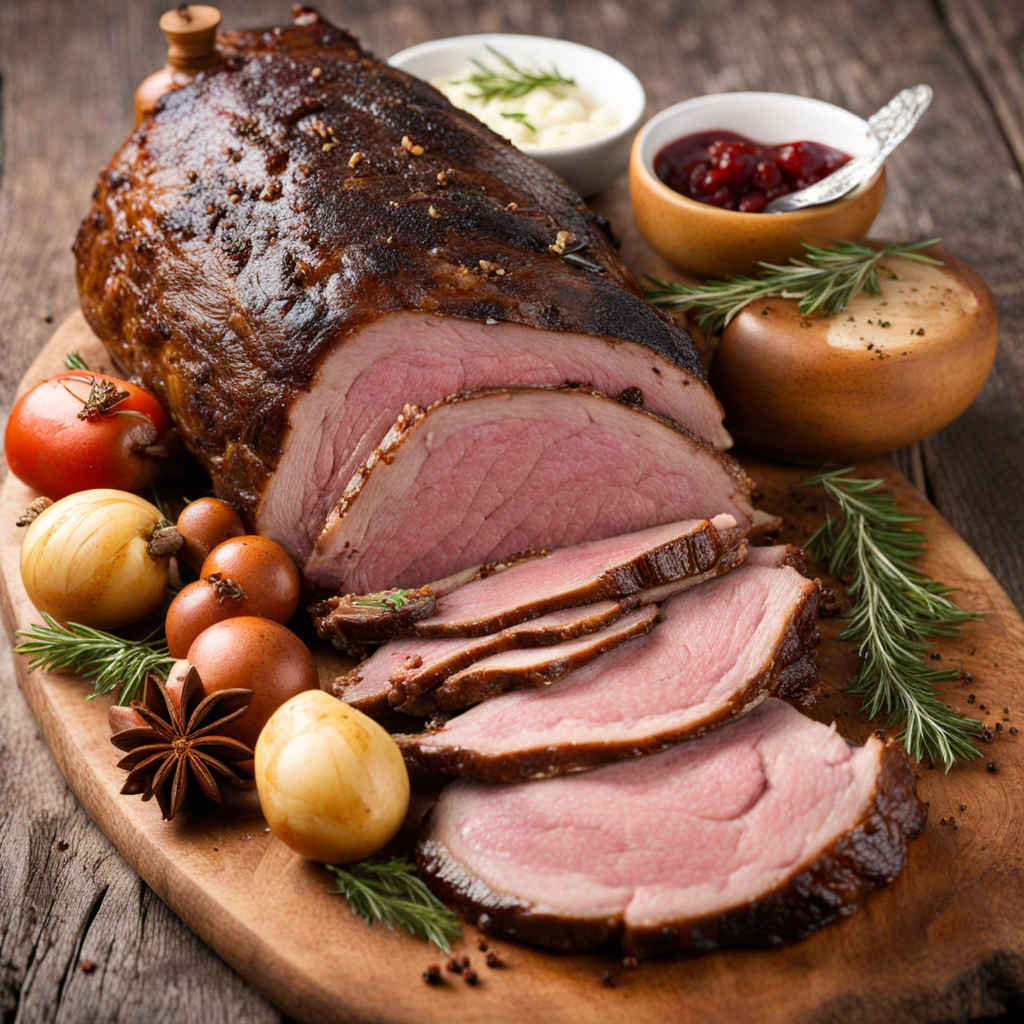Semmelknödel
Semmelknödel, a traditional Austrian dish, is a delightful bread dumpling that embodies the rustic charm of Central European cuisine. Made primarily from stale bread rolls, or "Semmeln," the dumplings are combined with ingredients like eggs, milk, and a touch of parsley to create a dough that is both hearty and comforting. The texture is key; when cooked properly, they are soft and fluffy on the inside while retaining a slightly firm exterior, making them an excellent accompaniment to a variety of dishes. These dumplings are often served alongside rich, savory gravies, particularly with meats such as roasted pork or beef. The subtle flavor of the Semmelknödel complements robust sauces beautifully, soaking up the flavors while adding a satisfying chew to each bite. In Austria, they are a staple at family gatherings and festive occasions, showcasing the country's culinary roots and love for wholesome comfort food. While Semmelknödel are traditionally enjoyed in a savory context, they can also be adapted to suit different palates by incorporating herbs, spices, or even cheese into the dough. This versatility allows for creative variations, making them a delightful discovery for food enthusiasts seeking new tastes. Whether enjoyed as a side dish or a main attraction, Semmelknödel offers a taste of Austrian heritage that is both nourishing and delicious, inviting you to savor every bite.
How It Became This Dish
A Journey Through Time: The History of Semmelknödel #### Origins Semmelknödel, or bread dumplings, is a quintessential dish of Austrian cuisine, particularly beloved in regions that were historically part of the Austro-Hungarian Empire. The name itself derives from "Semmel," a term used in Austria and parts of Southern Germany for a bread roll, and "Knödel," which translates to dumpling. The dish’s roots can be traced back to the late Middle Ages when the use of stale bread became a practical necessity. In an era where food preservation was paramount, repurposing leftover bread into dumpling form was a clever solution to minimize waste. The earliest known recipes for dumplings can be found in German-speaking regions, but the concept of transforming stale bread into a cohesive, flavorful dish is universal. Across Europe, variations of bread dumplings exist, from Italy’s gnocchi di pane to Poland’s kluski, showcasing the adaptability of this humble ingredient. #### Cultural Significance In Austria, Semmelknödel is more than just a side dish; it is a symbol of home cooking and regional identity. Traditionally served alongside hearty meats and rich gravies, such as Schweinsbraten (roast pork), Semmelknödel provides a perfect vehicle for soaking up flavorful sauces. This pairing highlights the Austrian culinary philosophy of balancing the richness of meat with the comforting, starchy notes of dumplings. The dish is particularly prominent in the cultural traditions of Austria’s rural areas, where home cooking is celebrated and family recipes are passed down through generations. Semmelknödel embodies the spirit of Austrian hospitality, often gracing tables during festive occasions and family gatherings. It reflects a lifestyle that values simplicity and sustenance, while also allowing for creativity in the kitchen. #### Development Over Time As Austria underwent various social and political transformations, so too did Semmelknödel evolve. The Austro-Hungarian Empire, which existed from 1867 to 1918, saw the exchange of culinary traditions across its vast territories. This cultural melting pot led to an array of regional variations of Semmelknödel, each reflecting local ingredients and customs. In regions like Bohemia (now part of the Czech Republic), for instance, the dumplings might include spices or even fillings, showcasing local preferences. In the early 20th century, with the rise of modern cooking methods and the availability of new ingredients, Semmelknödel began to be adapted for contemporary tastes. The introduction of eggs and milk into the dough added richness and altered the texture, making the dumplings even more appealing. Chefs started experimenting with flavorings, incorporating herbs, cheese, and even vegetables into the mixture, allowing for a broader interpretation of the classic recipe. The post-World War II era marked a significant change in Austrian cuisine, as the country sought to rebuild and redefine its identity. Semmelknödel enjoyed a renaissance during this time, as people sought comfort in traditional foods that evoked nostalgia and a sense of stability. It became a staple in both home kitchens and restaurants, often served as a side dish to hearty meals, reinforcing its place in the Austrian culinary canon. #### Modern Variations Today, Semmelknödel remains a beloved dish, with various interpretations found not only in Austria but also in neighboring countries. In Germany, for instance, Semmelknödel can be found in a slightly different form, often incorporating a richer variety of bread and spices. In the Czech Republic, knedlíky (dumplings) are a staple, sometimes filled with fruit or served alongside sweet dishes, showcasing the adaptability of the basic dumpling concept. In Austria, chefs continue to honor traditional recipes while also embracing innovation. Contemporary culinary trends have seen the emergence of gourmet variations of Semmelknödel, with ingredients like truffles, wild mushrooms, or artisanal bread being utilized to elevate this humble dish. Vegetarian and vegan adaptations have also gained popularity, as chefs explore plant-based alternatives that maintain the essence of Semmelknödel while catering to modern dietary preferences. #### The Experience of Enjoying Semmelknödel To truly appreciate Semmelknödel, one must consider the experience of savoring this dish. Traditionally, it is served in generous portions, often accompanied by rich gravies or sauces that perfectly complement the dumpling's texture. The first bite reveals a satisfying chewiness, a testament to the careful balance of ingredients. The taste is subtly savory, allowing the flavors of the accompanying meats and sauces to shine through, while also evoking a feeling of comfort and warmth. In Austrian culture, sharing a meal featuring Semmelknödel fosters connections among family and friends. Whether served during a festive gathering or a quiet dinner at home, the dish embodies a sense of togetherness, often prompting stories of family traditions and recipes passed down through generations. It is a reminder of the importance of food in shaping cultural identity and heritage. #### Conclusion Semmelknödel, with its rich history and cultural significance, stands as a testament to the ingenuity of home cooks throughout the ages. From its origins as a means of utilizing leftover bread to its status as a cherished dish in modern Austrian cuisine, Semmelknödel encapsulates the essence of comfort food. It reflects a culinary tradition that values sustainability, resourcefulness, and the joy of sharing meals with loved ones. As we savor the flavors of Semmelknödel today, we not only celebrate a delicious dish but also acknowledge the cultural narratives that shape our understanding of food. Each bite tells a story of history, adaptation, and the enduring connection between people and the meals they share, making Semmelknödel a timeless culinary treasure in the heart of Austria and beyond.
You may like
Discover local flavors from Austria







